Intel Core Duo: AOpen i975Xa-YDG to the Rescue
by Gary Key on May 4, 2006 8:00 AM EST- Posted in
- Motherboards
Audio Performance
We limited audio testing to the Rightmark 3D Sound version 2.2 CPU utilization test and tested with sound enabled to show the performance effects on several games. The Rightmark 3D Sound benchmark measures the overhead or CPU utilization required by a codec or hardware audio chip.
The Realtek ALC-880 HD audio codec on the AOpen board was tested with the recently released 1.36 driver set. The Realtek DirectSound audio drivers do not support more than 32 hardware buffers and the OpenAL 1.1 drivers do not support more than 30 hardware buffers at this time so the scores cannot be directly compared to the Creative Labs Sound Blaster X-Fi cards in the benchmarks.
It is interesting to note the reduced CPU utilization with the Core Duo or Opteron 165 as the load is balanced between each processor with the Realtek 1.36 drivers and the Creative drivers to a certain extent. However, these CPU utilization rate improvements with the dual-core setup does not have any bearing on actual game benchmarks as the reduction in frame rate percentages are the same as our single core score.
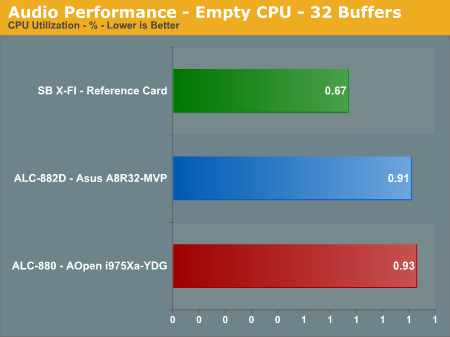
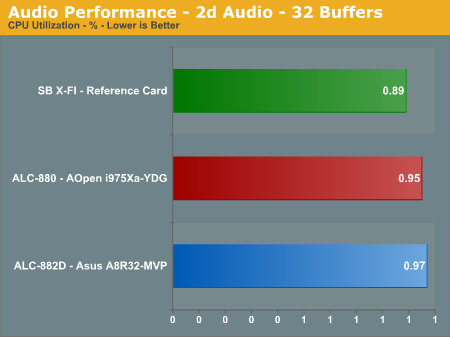
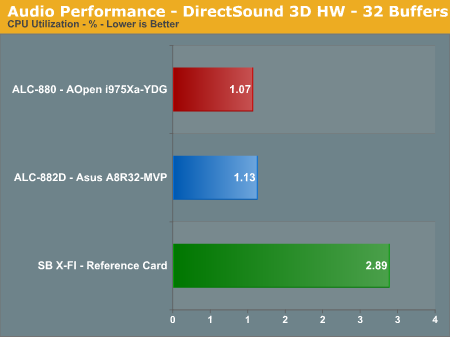
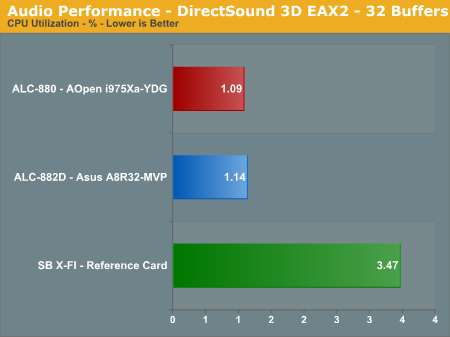
The Realtek ALC-880 codec offers very competitive CPU utilization rates when compared to the Realtek ALC-882 on the Asus board. The ALC-880 generates significantly better audio quality than the AC97 based systems and very similar audio quality to the ALC-882 solution. The ALC-880 was released before the ALC-882 but has nearly the same audio quality and performance in our testing. Our subjective headphone testing revealed a slight difference between the two codecs, with the output from the ALC-882 sounding clearer in the treble and mid-range tones. However, the difference was negligible when utilizing our 4, 5.1, or 7.1 speaker setup in a typical room environment. The Sound Blaster X-Fi has the lowest overall CPU utilization (single core systems) with the ALC-880 and the ALC-882 following closely. Let's find out how these results translate into real world numbers.
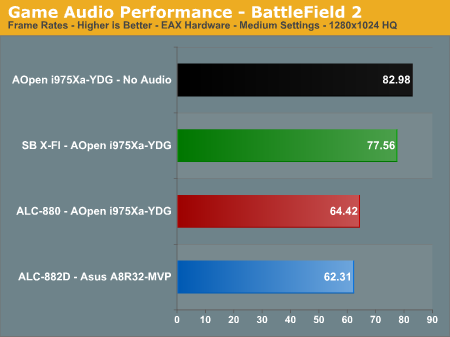
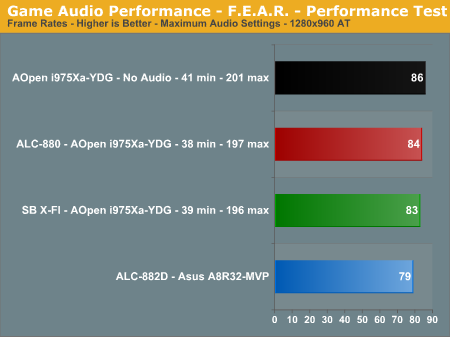
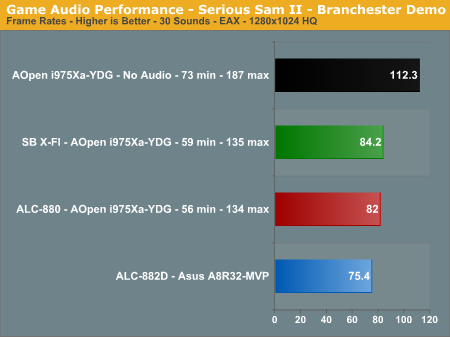
The audio performance numbers remain consistent as the Realtek ALC-880 consistently finishes near the SoundBlaster X-Fi in the benchmarks. Serious Sam II has an average loss of 37%, Battlefield 2 at 28%, and F.E.A.R. at 2%. F.E.A.R. is extremely GPU limited so the CPU has additional cycles to generate the audio streams required by the Realtek drivers.
The overall output quality of audio with the Realtek ALC-880 ranks with the ALC-882/883 series as the best of the on-board HD audio solutions we have heard to date, while performance continues to improve with each driver release. The vast majority of users should have no issues utilizing the ALC-880 as their primary audio solution considering the quality of audio and performance at this time in most applications.
Obviously, if you are a serious gamer, then a dedicated sound card is still useful to ensure consistent frame rate averages across a wide variety of games, and in the case of the Sound Blaster X-Fi, you also get improved audio quality and EAX3/4/5 support. If you'd like more details on the Realtek solution, you can refer to the Realtek ALC-880 Specifications.










81 Comments
View All Comments
Gary Key - Friday, May 5, 2006 - link
Sorry, being a selfish s.o.b. with this drive, actually I am testing two of them for an upcoming article. :)
sabrewulf - Thursday, May 4, 2006 - link
I haven't been following the development of Conroe too closely, but isn't this chip essentially performing like Conroe will? Or am I missing something?Some of the tests were impressive, but the gaming tests were certainly not "20-40%" improvement over AMD like everyone is wishing.
MrKaz - Thursday, May 4, 2006 - link
And "will" never be.Don’t forget Intel was using:
- Some special ATI driver.
- Crossfire setup (maybe modified),
20%~40% that you will never get, unless you have such kind of configuration.
On non SLI/Crossfire configuration will never be higher than 5%, 10% improvement...
And thanks that a lot to the 4MB cache, and minor processor (P3 redesign) changes.
Don’t forget that the Intel dual core with 4MB shared cache can act as one BIG single core processor with 4MB cache and the second core with 0MB of cache for the extra “stupid” calc...
IntelUser2000 - Thursday, May 4, 2006 - link
LOL. I always doubt that people can be such a dumb fanboy even I see them over and over again in time.
How do you explain Xtremsystems benchmark, and all the architectural advantages?? Did Netburst's poor showing really blind you??
MrKaz - Friday, May 5, 2006 - link
Fun boy me?It's you who calls him self by the stupid nick name Inteluser2000.
Some time there are complete morons here and you are one of them.
ME the "fan boy" has to "defend" Intel, a thing that you with your little brain can’t do.
Read my reply to your fan boy friends, there you will find why conroe will be good, and it's not because it's Intel.... dumb moron....
redbone75 - Thursday, May 4, 2006 - link
I don't think it was a "special" driver per se, if I recall the driver had some changes made in order to recognize Conroe.
I just love how a lot of people refer to Conroe as a P3 redesign as if it's something so bad. No, it's not a P3 redesign, there are elements of what made the P3 so successful incorporated into the chip, but that's not what makes the chip so awesome. Also, so what if it is ultimately just a "P3 redesign" as you put it? You use what works, and obviously this works. Hey, the K7 core was pretty good, and K8 is so well designed that AMD can ride it for a few more years.
MrKaz - Friday, May 5, 2006 - link
"in order to recognize Conroe"Why they need to recognize Conroe?
-Would work?
-Did work but with inferior performance?
-Special optimizations?
-New instruction set (SSE4) support for improved performance?
Questar - Thursday, May 4, 2006 - link
Wow, some fanboys are still in denial.This is an interim MOBILE chip that just put the smack down on an Opteron. What's going to happen when the real thing comes out?
MrKaz - Friday, May 5, 2006 - link
When the real thing come out? That’s easy:Core duo plus:
- 2MB cache (+5%~10%)
- 2X FSB (+4%~8%)
- 800Mhz DDR2 (3%~6%)
- x64 support (0%)
- Higher clock speed 2.1Ghz to 3.3Ghz (anyone can say 50% performance increase?)
I’m not a fan boy, it’s you Intel stupid morons that can even read and make some thought why should Conroe be faster than AMD Athlon 64….
Go back and reread the article about:
Intel Core versus AMD's K8 architecture
Don’t expect conroe be very different from core duo... I’m not saying that’s bad…
Questar - Friday, May 5, 2006 - link
You forgot a couple of things:Addidtional ALU Unit
Twice the SSE performace
Better code reordering
Larger reservation station
New micro-ops